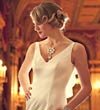eleGALA tip
You can search hundreds of designer wedding dresses in our interactive wedding dress photo gallery.
Wedding Dress Fabric Guide
Determine the most appropriate wedding dress fabric for your bridal look.
Just what is charmuese, and what does it have to do with your wedding dress? In addition to silhouette and neckline, fabric plays a key role in selecting the right gown, since the same style of dress looks and feels very different in a variety of fabrics. And while most of us can discern between satin and lace, what about shantung, crepe, or organza?
Our handy guide to wedding dress fabrics will help you sort through the sea of silk mikado and chantilly lace to find the most appropriate fabric for your wedding-day look.
Wedding Dress Fabrics
Silk
The most common, cherished, and priciest wedding gown fabric, silk is a smooth and soft natural fiber. Silk threads are woven to create tons of other fabrics, such as satin, duchesse satin, shantung, charmeuse, chiffon, organza, and even tulle.
Satin
Very common in wedding gowns, satin is a densely woven silk with a lustrous sheen on one side.
Duchesse Satin
More affordable than pure silk satin, duchesse satin is a lightweight blend of silk and rayon (a less-expensive, synthetic fiber).
Charmeuse
Lightweight and soft, charmuese is a satin-like fabric with a slightly more subdued luster.
Shantung
A plain-weave silk or cotton fabric, shantung is notable for its rubbed, rough texture.
Dupioni
Dupioni silk has a similar finish to shantung, but with a thicker, coarser finish and a slight sheen.
Silk Mikado
A blended silk, silk mikado is usually heavier than regular silk.
Chiffon
Soft, sheer, and transparent, chiffon can be made from silk (more expensive) or rayon (more affordable). Due to its delicate transparency, chiffon is often layered and is popular for sleeves, overskirts, and wraps.
Taffeta
A crisp, smooth, and light-weave fabric with a slight rib, taffeta is made from silk or synthetic fibers.
Moire
A heavy silk taffeta, moire is noted for a subtle, wavy design.
Organdy
Organdy is a stiff, transparent silk or rayon fabric.
Tulle
A fine, starched netting made of silk, nylon, or rayon, tulle is often used for skirts and veils.
Organza
A sheer, stiff fabric of silk or synthetic material, organza is similar to tulle, but less coarse and more flowing.
Silk Gazar
A four-ply silk organza.
Illusion
A fine, sheer net fabric, illusion is typically used on necklines or sleeves.
Brocade
A popular winter fabric, brocade is a Jacquard-woven (a type of loom) fabric with an ornate raised design. Brocade is a popular winter fabric.
Damask
Similar to brocade with raised designs, but lighter in weight.
Velvet
A soft, thick fabric with a felted face and plain underside – typically a winter fabric.
Crepe
A soft silk fabric with a gauzy texture and a crinkled surface.
Georgette
A sheer, lightweight fabric, georgette is made of polyester or silk with a crepe surface.
Eyelet
Featuring open-weave embroidery, breezy eyelet is typically associated with spring and summer.
Peau de Soie
French for “skin of silk,” peau de soie is a satin-faced silk or synthetic fabric with a dull luster, fine ribs, and a grainy appearance.
Jersey
An elastic knit fabric, jersey has lengthwise ribs on the face and crosswise ribs on the underside.
Faille
A woven fabric of silk, cotton, or rayon, faille is a heavier fabric with a structured, ribbed finish.
Gabardine
A tightly woven, tough fabric with a durable finish and single diagonal lines on the face, gabardine is often used to make suits, overcoats, and trousers.
Batiste
A lightweight, soft, and transparent fabric in plain weave.
Polyester
An inexpensive synthetic fiber that can be woven into almost any fabric.
Rayon
A smooth manufactured fabric that is similar to silk, but more elastic and affordable.





